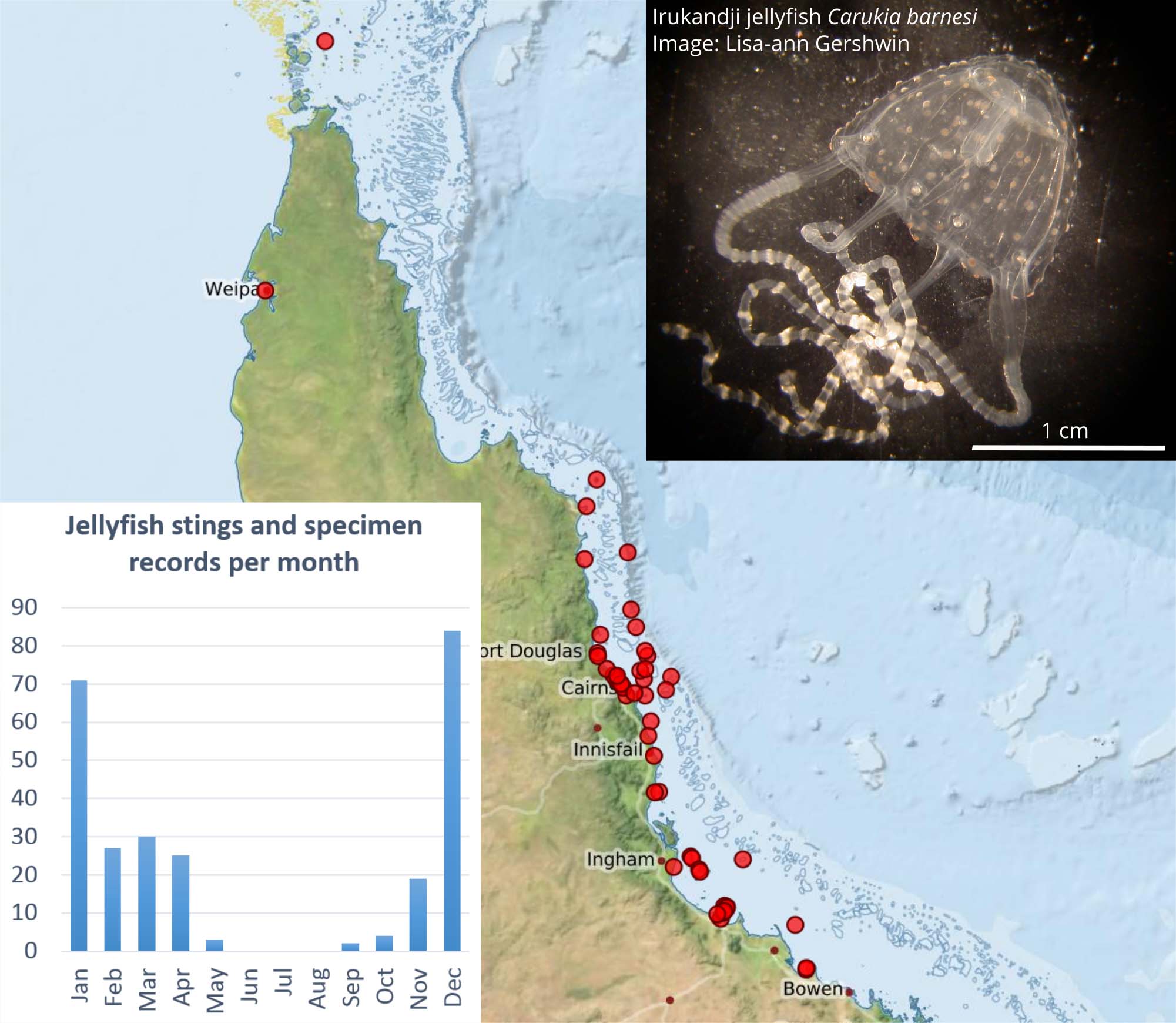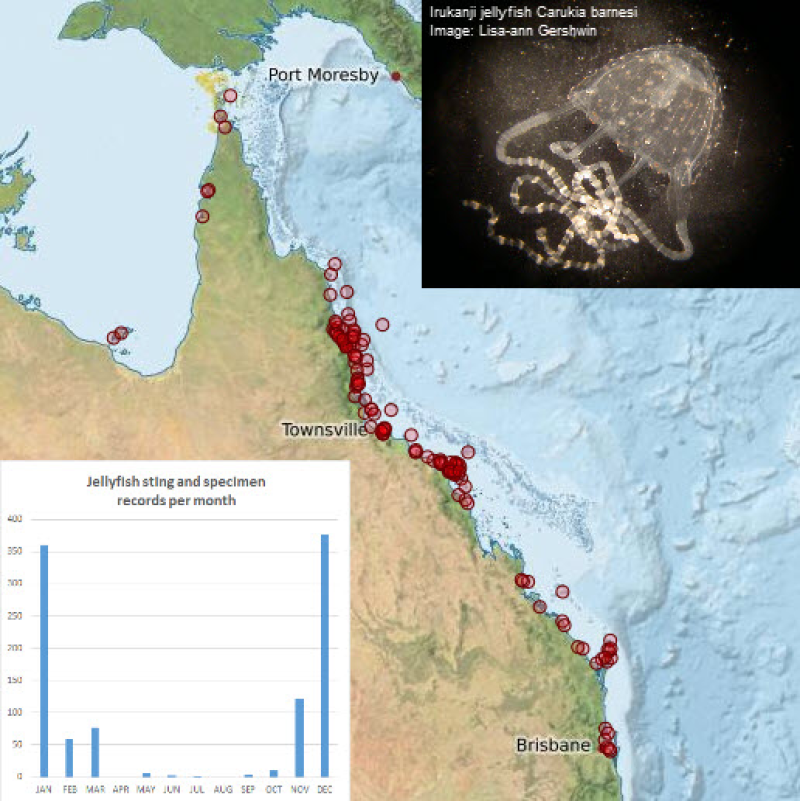Oceans and Atmosphere, CSIRO
Type of resources
Topics
Contact for the resource
Provided by
Representation types
status
-
Venomous Jellyfish Database (Sting events and specimen samples - March 2017) (NESP TWQ 2.2.3, CSIRO)

A later version of this dataset exists published 2019-01-18, accessible through the data links on this page. This dataset contains records of sting events and specimen samples of jellyfish (Irukandji) along the north Queensland coast from December 1998 to March 2017. This dataset contains an extract (265 records in CSV format) of the publicly available data contained in the Venomous Jellyfish Database. The full database contains approximately 3000 sting events from around Australia and includes records from sources that have not yet been cleared for release. This extract was made for eAtlas as part of the 2.2.3 NESP Irukandji forecasting system project and used as part of the development of the Irukandji forecasting model. The data was compiled from numerous sources (noted in each record), including Lisa-ann Gershwin and media reports. The sting data includes primary information such as date, time of day and locality of stings, as well as secondary details such as age and gender of the sting victim, where on the body they were stung, their activity at the time of the sting and their general medical condition. Limitations: This data shows the occurrence of reported jellyfish stings and specimens along the north Queensland coast. It does NOT provide a prediction of where jellyfish or jellyfish sting events may occur. These records represent a fraction of known sting events and specimen collections, with more being added to the list of publicly available data as permissions are granted. Historical data dates may be coarse, showing month and year that the sting occurred in. Some events have date only. Methods: This data set contains information on sting events and specimen collections that have occurred around Australia, which involved venomous jellyfish (Irukandji syndrome-producing species in the genera Carukia, Malo, Morbakka). This data was collected over numerous years by Lisa-ann Gershwin from various sources, predominantly news reports. This data was entered into an Excel spreadsheet, which formed the basis of the Venomous Jellyfish Database. This database was developed as part of the 2.2.3 NESP Irukandji forecasting system project. Some data have been standardised, e.g., location information and sting site on the body. Data available to the public have been approved by the data owners, or came from a public source (e.g. newspaper reports, media alerts). Format: Comma Separated Value (CSV) table. eAtlas Note: The original database extract was provided as an Excel spreadsheet table. This was converted to a CSV file. Data Dictionary: - CSIRO_ID: Unique id - EVENT_TYPE: Type of event – sting or specimen - STATE: State in which event occurred - REGION: Broader region of State the event occurred in - LOCAL_GOV_AREA: Local government area that the event occurred in – if known - MAIN_LOCALITY: Main locality that the event occurred in - SITE_INFO: Site details/comments - YEAR: Year event occurred - MONTH: Month event occurred - DAY: Day of the month the event occurred - EVENT_TIME: Time the event occurred HH24:MI If time is unknown then NULL - EVENT_RECORDED: time/date event reported e.g. early afternoon, morning, on weekend - EVENT_COMMENTS: Comments about the event - LAT: Latitude in decimal degrees - LON: Longitude in decimal degrees - LOCATION_ACCURACY: How accurate the location is - EVENT_OFFSHORE_ONSHORE: Where the event occurred (if known) – beach, island, reef - LOCATION_COMMENTS: Comments relating to the location of the event - WATER_DEPTH_M: Depth of water, in metres, that the event occurred in (if known) - AGE: Age of patient if known - SEX: Gender of patient if known - HOME: Home state/county of patient - HOSPITAL: Hospital the patient was treated at (if known) - STING_SITE_REPORTED: Reported sting site on the body - STING_SITE_BODY: Standardised area on body that sting was reported – upper limb, lower limb etc. - NUMBER_STINGS: Number of stings recorded, if known - VISIBLE_STING: The nature of visible sting marks, if reported - PPE_WORN: Was Personal Protective Equipment (PPE) worn? - PATIENT_COMMENTS: Comments about the patient - TIME_TO_ONSET: Delay between sting and onset of symptoms, if reported - PATIENT_CONDITION: State the patient was in, e.g. distressed, calm, stable - BLOOD_PRESSURE: Comments relating to blood pressure of the patient - NAUSEA_VOMITING: Did the patient experience nausea and/or vomiting? - PAIN: Location and/or intensity of pain experienced by the patient - SWEATING: Did the patient experience sweating? - TREATMENT: What treatment the patient was given - DISCHARGED: When the patient was discharged from hospital - ONGOING_SYMPTOMS: What ongoing symptoms the patient is experiencing - NEMATO_SAMPLES: Were nematocyst samples taken? - SPECIES_NAME: Species name, if determined - PATROL: Was the sting on a patrolled beach - CURATOR: Where the data came from e.g. Gershwin = Lisa-ann Gershwin - DATA_CODE: Access constraint on data - REFERENCE: Source of the information for event - ENTERED_BY: Who entered the data - ENTERED_DATE: When the data was entered References: Gershwin, L. (2013). Stung! On Jellyfish Blooms and the Future of the Ocean. Chicago, University of Chicago Press. Lisa-Ann Gershwin , Monica De Nardi , Kenneth D. Winkel & Peter J. Fenner (2010) Marine Stingers: Review of an Under-Recognized Global Coastal Management Issue, Coastal Management, 38:1, 22-41, http://dx.doi.org/10.1080/08920750903345031 Gershwin L, Condie SA, Mansbridge JV, Richardson AJ. 2014 Dangerous jellyfish blooms are predictable. J. R. Soc. Interface 11: 20131168. http://dx.doi.org/10.1098/rsif.2013.1168 Gershwin, L., A. J. Richardson, K. D. Winkel, P. J. Fenner, J. Lippmann, R. Hore, G. Avila-Soria, D. Brewer, R. J. Kloser, A. Steven and S. Condie (2013). Biology and ecology of Irukandji jellyfish (Cnidaria: Cubozoa). Advances in Marine Biology 66: 1-85. Data Location: This dataset is filed in the eAtlas enduring data repository at: data\custodian\2016-18-NESP-TWQ-2\2.2.3_Jellyfish-early-warning\AU_NESP-TWQ-2-2-3_CSIRO_Venomous-Jellyfish-DB
-

This dataset contains records of sting events and specimen samples of jellyfish (Irukanji, Halo irukanji, Box jellyfish and Morbakka) from the Venomous Jellyfish Database. This dataset contains an extract of 1081 sting events (in CSV format) from along the north Queensland coast between December 1883 to March 2017. The full database contains approximately 3000 sting events from around Australia and includes records from sources that have not yet been cleared for release. This extract from the Venomous Jellyfish Database was made for eAtlas as part of the 2.2.3 NESP Irukandji forecasting system project. It contains jellyfish sting and specimen information. Data were compiled from numerous sources (noted in each record), including Lisa-ann Gershwin and media reports. These data will be used as part of the Irukandji forecasting model. The extract data file contains data that is publicly available. The sting data includes primary information such as date, time of day and locality of stings, as well as secondary details such as age and gender of the sting victim, where on the body they were stung, their activity at the time of the sting and their general medical condition. Limitations: This data shows the occurrence of reported jellyfish stings and specimens along the north Queensland coast. It does NOT provide a prediction of where jellyfish or jellyfish sting events may occur. These records represent a fraction of known sting events and specimen collections, with more being added to the list of publicly available data as permissions are granted. Historical data dates may be coarse, showing month and year that the sting occurred in. Some events have date only. Methods: This data set contains information on sting events and specimen collections that have occurred around Australia, which involved venomous jellyfish (Irukandji syndrome-producing species in the genera Carukia, Malo, Morbakka). These data were collected over numerous years by Lisa-ann Gershwin and others from various sources (primarily media). These data were entered into an excel spreadsheet, which formed the basis of the Venomous Jellyfish Database. This database was developed as part of the 2.2.3 NESP Irukandji forecasting system project. Some data have been standardised, e.g., location information and sting site on the body. Data available to the public have been approved by the data owners, or came from a public source (e.g. newspaper reports, media alerts). Format: This dataset consists of one Comma Separated Value (CSV) table containing information on jellyfish events along the north Queensland coast. eAtlas Note: The original database extract was provided as an Excel spreadsheet table. This was converted to a CSV file. Data Dictionary: CSIRO_ID: unique id EVENT_TYPE: type of event – sting or specimen STATE: state in which event occurred REGION: broader region of State the event occurred in LOCAL_GOV_AREA: local government area that the event occurred in – if known MAIN_LOCALITY: main locality that the event occurred in SITE_INFO: site details/comments YEAR: year event occurred MONTH: month event occurred DAY: day of the month the event occurred DATE_RANGE: date range event may have occurred in EVENT_TIME: time the event occurred HH24:MI. If time is unknown then NULL EXACT_DATE: if exact date unknown then N. Use with DATE_RANGE EXACT_TIME: if exact time unknown then N. TIME_REPORTED: time event reported e.g. early afternoon, morning EVENT_RECORDED: date event reported e.g. on weekend, in February, Jan-March EVENT_COMMENTS: comments about the event LAT: latitude in decimal degrees LON: longitude in decimal degrees LOCATION_ACCURACY: How accurate the location is, 0=within a few hundred metres, 1=within a few kilometres, 2=more than a few kilometres EVENT_OFFSHORE_ONSHORE: where the event occurred (if known) – beach, island, reef LOCATION_COMMENTS: comments relating to the location of the event WATER_DEPTH_M: depth of water, in metres, that the event occurred in (if known) AGE: number: age of patient if known SEX: gender of patient if known HOME: home state/county of patient HOSPITAL: hospital the patient was treated at (if known) RETRIEVAL: method by which the patient was transported to hospital (if known) STING_SITE_REPORTED: reported sting site on the body STING_SITE_BODY: standardised area on body that sting was reported – upper limb, lower limb etc. NUMBER_STINGS: number of stings recorded, if known VISIBLE_STING: the nature of visible sting marks, if reported PPE_WORN: was Personal Protective Equipment (PPE) worn? PATIENT_COMMENTS: comments about the patient TIME_TO_ONSET: delay between sting and onset of symptoms, if reported PATIENT_CONDITION: state the patient was in, e.g. distressed, calm, stable BLOOD_PRESSUREL: comments relating to blood pressure of the patient NAUSEA: did the patient experience nausea and/or vomiting? PAIN: location and/or intensity of pain experienced by the patient SWEATING: did the patient experience sweating? TREATMENT: what treatment the patient was given DISCHARGED: when the patient was discharged from hospital ONGOING_SYMPTOMS: what ongoing symptoms the patient is experiencing NEMATO_SAMPLES: were nematocyst samples taken? SPECIES_NAME: species name, if determined PATROL: was the sting on a patrolled beach CURATOR: where the data came from e.g. Gershwin = Lisa-ann Gershwin DATA_CODE: access constraint on data PUBLIC_REFERENCE: source of the information for event ENTERED_BY: who entered the data ENTERED_DATE: when the data was entered References: Gershwin, L. (2013). Stung! On Jellyfish Blooms and the Future of the Ocean. Chicago, University of Chicago Press. Gershwin, L., De Nardi, M., Winkel, K.D., and Fenner, P.J. (2010) Marine Stingers: Review of an Under-Recognized Global Coastal Management Issue. Journal of Coastal Management, 38:1, 22-41, DOI: 10.1080/08920750903345031 Gershwin L, Condie SA, Mansbridge JV, Richardson AJ. 2014 Dangerous jellyfish blooms are predictable. Journal of the Royal Society. Interface 11: 20131168.http://dx.doi.org/10.1098/rsif.2013.1168 Gershwin, L., Richardson, A.J., Winkel, K.D., Fenner, P.J., Lippmann, J., Hore, R., Avila-Soria, G., Brewer, D., Kloser, R.J., Steven, A. and Condie, S. (2013). Biology and ecology of Irukandji jellyfish (Cnidaria: Cubozoa). Advances in Marine Biology 66: 1-85. Data Location: This dataset is filed in the eAtlas enduring data repository at: data\custodian\2016-18-NESP-TWQ-2\2.2.3_Jellyfish-early-warning\AU_NESP-TWQ-2-2-3_CSIRO_Venomous-Jellyfish-DB
 eAtlas Data Catalogue
eAtlas Data Catalogue